Advertisement
NutraSweet Nation and the Mainstreaming of Artificial Sweeteners
Published 2015
By 1980 artificially sweetened sodas and desserts could be found throughout supermarket aisles. See soda. These products, however, remained choices for dieters or people watching their weight. The situation changed with the introduction of aspartame, under the brand name NutraSweet. Using a technique known as supplier-initiated ingredient branding, Searle Pharmaceutical sent 5 million American households a small package of brightly colored gumballs attached to a flyer. While consumers tasted the newly approved sweetener NutraSweet, they read pages of testimonials from customers who found it “the best thing since the invention of food.” This combination of sending a sample associated with fun and pleasure rather than with diets and deprivation, and instructing consumers to go look for (and demand) this new ingredient, revolutionized the place of artificial sweeteners in the U.S. marketplace. No longer a substitute, aspartame became the most modern, healthful option for indulging in sweets. And, according to advertising material, it was not artificial. “If you’ve had bananas and milk, you’ve eaten what’s in NutraSweet,” explained one early advertisement. A methyl ester of aspartic acid and phenylalanine, aspartame did have things in common with bananas and milk. But it was not derived from milk or bananas, nor was it produced in a way that would have been considered “natural” to most consumers. By successfully presenting NutraSweet as both modern and natural, and by turning consumers into advocates, NutraSweet’s promoters converted the nation to artificial sweetener consumers. Only five years after its introduction, the red-and-white swirl denoting a product’s use of 100 percent NutraSweet had become ubiquitous, and product sales reached over $700 million worldwide. In the 1980s alone, NutraSweet replaced roughly a billion pounds of sugar in American diets. By 1990 three-quarters of the U.S. population had tried NutraSweet. Many of these new consumers were children. With NutraSweet’s superior taste to saccharin and new fears of childhood obesity on the rise, an artificial sweetener was for the first time perceived as the most healthful sweetening option for the family.


